When you think of bonsai trees, your first thought it probably going to be something like a jasmine or fir, or maybe some of the indoor bonsai species like Ficus or sweet plum. But there’s a different kind of plant you might want to consider for the art – the Chinese pepper. It’s a beautiful, intriguing plant that works really well for beginners and works well as an indoor bonsai or an outdoor bonsai, depending on your climate and time commitment to the art.
Let’s take a look at the unique plant and see why it might be a great choice for your bonsai hobby.

The tree is attractive as a bonsai any time of year.
©lssa_007/Shutterstock.com
What Makes a Chinese Pepper Good for Bonsai?
The Chinese pepper bonsai is a great choice because it’s easy to care for, adds some real color pop to the space, works as an indoor or outdoor bonsai, and produces some pretty tasty fruit you can use for cooking at home. This all makes it an excellent plant for beginner, intermediate, and advanced bonsai enthusiasts alike.
Chinese Pepper Classification
The Chinese pepper goes by many different names. The botanical name is Zanthoxylum piperitum, while its common names include Chinese pepper, Japanese pepper, Korean pepper, Szechuan pepper, anise pepper, mountain pepper, and Japanese prickly ash. There is also another Chinese pepper that’s the Capsicum chinense, which is a different species altogether. The two have some similarities, but they shouldn’t be confused for each other in the bonsai art form.
The plant is an aromatic spiny shrub that’s deciduous and belongs to the citrus and rue family Rutaceae, which is native to Japan and Korea. It is cultivated for its spicy seeds that are used in culinary forms.
Chinese Pepper Bonsai Description
The Chinese pepper bonsai produces yellow-green flower clusters in the early to mid-spring, with male and female plants. The flowers on the male plant are sometimes consumed as hana-sanshō (edible pepper flowers), while the flowers on the female plant are what produce the peppercorns (or berries). In autumn, the berries ripen and turn red and burst, revealing and scattering their black seeds. Branches on the Chinese pepper grow pairs of sharp thorns and alternately arranged compound leaves with 5 to 9 pairs ovate leaflets. The plant is also the host for Japanese indigenous swallowtail butterflies and the citrus butterfly that has spread to Hawaii.
Origins and Uses of Chinese Pepper
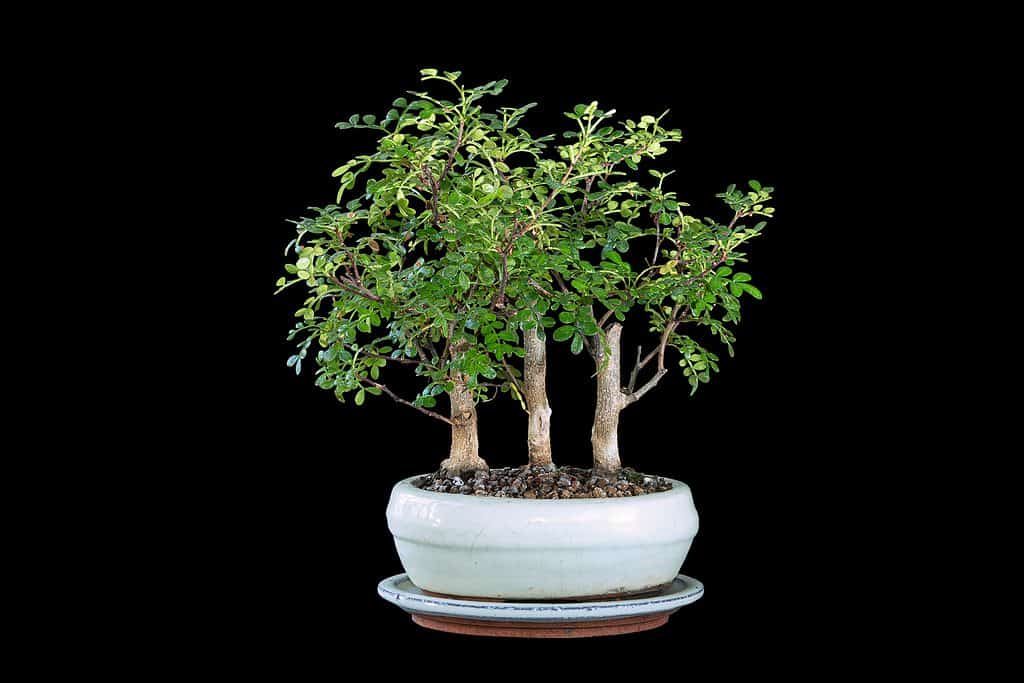
They’re often grown in forest style as bonsai.
©taviphoto/Shutterstock.com
The Chinese pepper grows natively across much of Asia, particularly in Japan, Korea, and the Himalayan region. The plant typically hits a height of 6 feet when left to nature and is used as a peppery herb somewhat similar to black pepper. The difference between the Chinese pepper and the Japanese pepper is minute: one is endemic to Chine, the other to Japan.
The dried seeds of the tree are where the flavor is at, so after the female plant produces the fruit and splits open, the seeds attract the attention for culinary use. The semi-evergreen plant is attractive year-round, which is part of why it has become popular among bonsai enthusiasts. Additionally, the plant is cultivated for those flavorful seeds, which are high in antioxidants.
How to Grow Chinese Pepper as Bonsai
The Chinese pepper is a popular bonsai thanks to its ease of care. However, it does still have some specific requirements which should be met when caring for this spicy plant, whether indoors or out. The big things to pay attention to are water levels, humidity, temperature, and light.
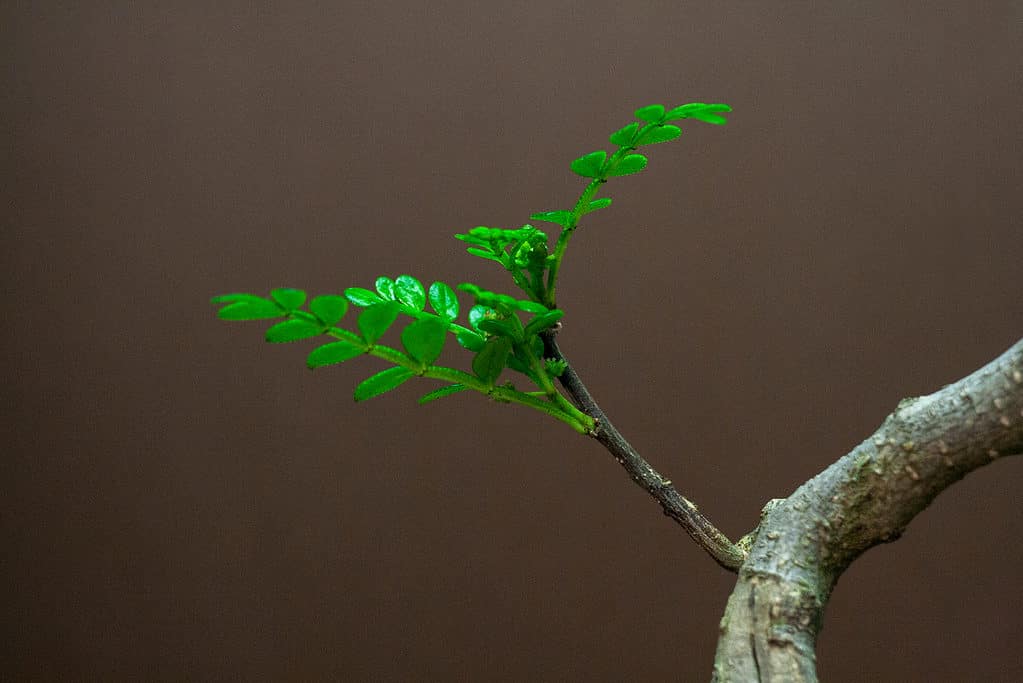
The foliage isn’t quite what you’d expect of a pepper plant.
©pjatnica/Shutterstock.com
Planting Location
The Chinese pepper is a bonsai that may be grown indoors or outdoors, depending on your climate and level of care, window situation, and/or growing light setup. If you have sufficient lighting, provided by either a southern facing window or growing lights, the Chinese pepper bonsai will thrive indoors. Ideally, though, it will be placed outdoors in summer in a sunny location where it will receive plenty of sunlight, and natural air circulation, and shade in the afternoon. In the hottest times of the summer, it should be kept in partial shade locations.
In a nutshell, that is:
- May be grown indoors or outdoors
- With sufficient light (sunlight or additional grow lights)
- Kept away from air vents, heaters, air conditioners, and doors opening outside
- Shade for afternoons, if kept outdoors
Lighting
The Chinese pepper bonsai requires a fair amount of light to thrive. It warmer months, ideally it will be grown outdoors in a warm (but not overly warm), sunny location with afternoon shade. In winter, it should be brought indoors and kept in a well-lighted area, using natural lighting as much as possible and grow lights to make up for any lack.
If you notice the plant has limited leaves, it probably needs more light and should either be given a grow light or moved to a brighter location with more hours of direct sunlight.
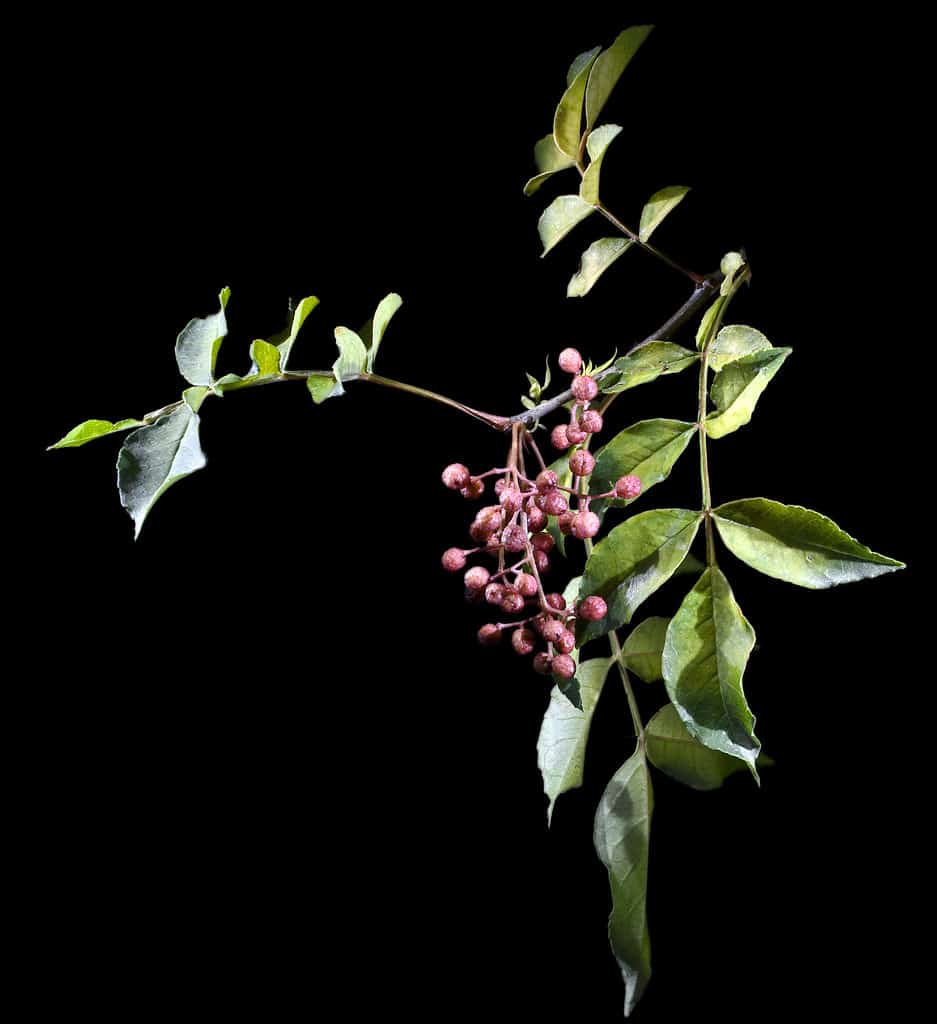
The fruit looks like berries.
©
Temperature
The Chinese pepper bonsai is a temperate climate plant, thriving in temperatures between 60 and 75-degrees F. It does not do well below 50-degrees F or in temperatures exceeding 80-degrees F. If your winter temperatures dip below 50, bring the plant indoors and keep in a moderate-climate room in the house with proper lighting and air circulation. If your summer months exceed 80-degrees F, you will also want to keep the plant indoors during hotter months.
Humidity
One of the trickiest parts of growing Chinese pepper bonsai trees is the humidity level. They are temperate climate plants and do not do well in either cold or hot weather, which often means moderate humidity is also needed. When your Chinese pepper is kept indoors, avoid air vents, heaters, air conditioners, and doors that open to the outside to help control humidity. You’ll also want to mist the leaves frequently to keep them moderately moist. In summer, you’ll need to mist daily; in winter, every other day or every few days may be enough, unless your home is particularly warm and air dry. For example, in Chicago, the winter air indoors tends to be dry, so the plant will likely still need misting daily. A good rule of thumb on this is when static electricity abounds, mist lightly every day.
Watering
Your Chinese pepper bonsai needs a proper moisture balance in the soil. Some things you can do to keep your pepper happy and thriving include:
- Use a moisture meter to check soil daily to ensure levels are where they should be.
- Water the soil when the surface is dry but not before then.
- Don’t let the soil get overly dry (“crunchy”) before watering.
- Water the pepper bonsai frequently in summer, often twice daily in the hottest months.
- Reduce watering frequency in winter unless your indoor air is particularly dry.
- Keep the bonsai in a shallow tray in winter or whenever indoors. Fill the tray with gravel and keep filled with water.
- If you notice the soil remains moist after 3 or so days past watering, or seems soggy, check to make sure the drainage holes aren’t blocked. You don’t want the soil to become stagnant with old water.
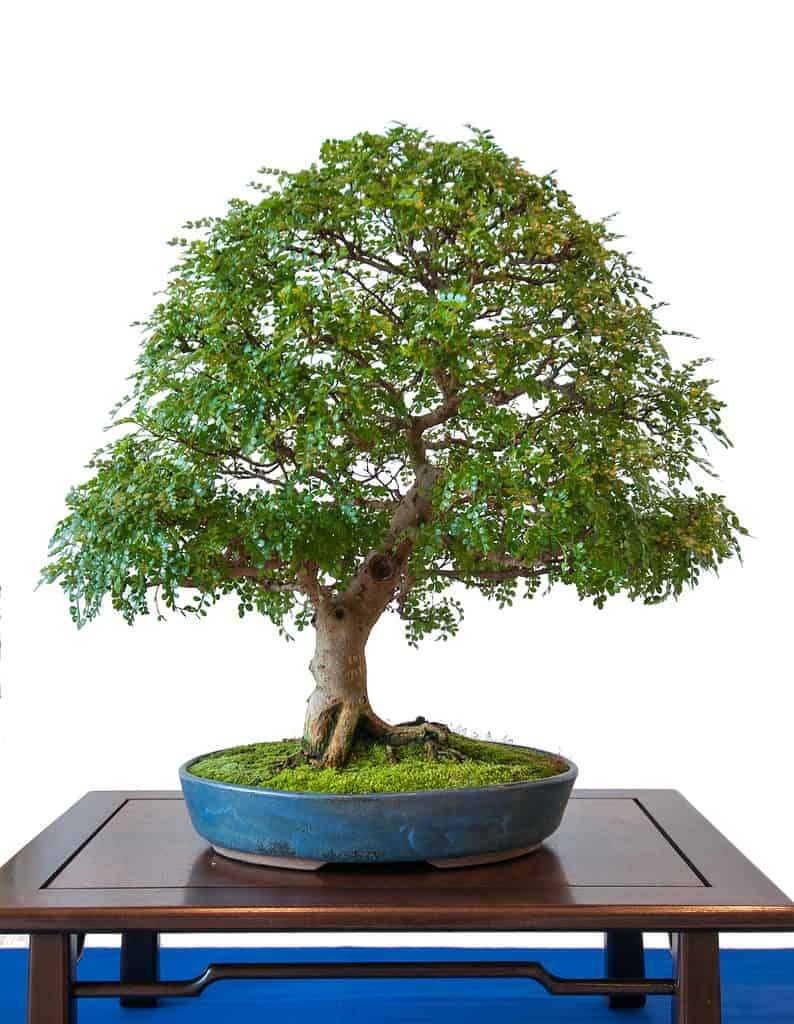
They look like amazing trees when trained as bonsai, despite being “pepper plants.”
©Bernd Schmidt/Shutterstock.com
Feeding
The season determines the frequency at which your Chinese pepper bonsai needs feeding. Your plant will be best served by using liquid bonsai fertilizer or half-strength standard liquid fertilizers. Granular fertilizer may be used in summertime.
- In winter, feed with liquid fertilizer once per month.
- From spring to autumn, feed with liquid or granular fertilizer every two weeks.
- Do not fertilize the bonsai until at least 4 weeks after it has been re-potted.
- Never fertilize a weakened bonsai tree. Instead, maintain light and water needs and allow the tree to regain strength before “asking” it to produce leaves (which fertilizer does).
Pruning, Shaping, and Wiring
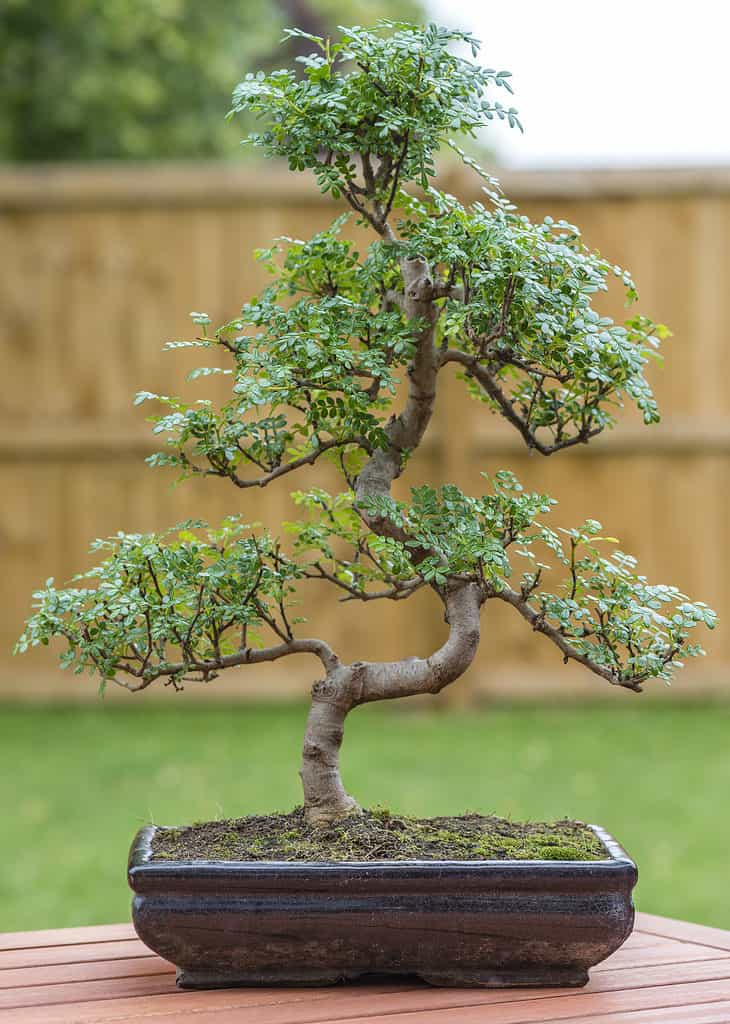
Chinese peppers thrive both indoors and outdoors as bonsai, when properly cared for.
©Paul_Brighton/Shutterstock.com
Chinese pepper bonsai are fast growers, often gaining as much as 2 to 4 inches per month in the springtime and summer, when cared for properly. One 2 to 4 inches have grown up, it’s best to prune back to the original crown with sharp bonsai shears. This allows the bonsai to regrow stronger, healthier, denser foliage as the season progresses. The plant is perennial, so does best with frequent pruning.
Or, when 4 leaflets have formed, trim back new branches to 2 sets, ensuring that the tree still has plenty of foliage.
Wiring of the Chinese pepper bonsai may be done any time of year. If any damage is done to the bark or branches, be sure to use healing wound paste and leave off wiring again until the wounds have healed. The shoots do harden quickly, though, so wiring when the branches are young and supple is necessary, else you might find the branches break or are too difficult to bend.
The Chinese pepper bonsai may be trained into many different shapes and styles, most frequently the free upright, the slanting bonsai, or semi-cascade. The formal upright and broom styles don’t work particularly well for Chinese pepper, though.
Re-potting
Chinese pepper bonsai should be re-potted every 2 to 3 years in early springtime. The roots should be pruned somewhat (maybe 20 to 25%). Gently remove soil from the roots with a root rake and re-pot in a bonsai pot the appropriate size, ensuring that it will drain properly. Some recommend using a fine mesh screen at the bottom of the pot to allow for proper drainage without loss of nutrients.
- Remove the bonsai from the original pot and gently rake out the roots.
- Prune some of the roots.
- Place a fine mesh screen in the cleaned, sterilized bonsai pot.
- Add a layer of gravel or pebbles on top of the screen.
- Add a layer of bonsai potting mix of equal portions leaf mold or peel, soil, and grit. Or a 2 to 1 ratio of Akadama and pumice.
- Replace the bonsai into the pot and fill in the rest of the pot with the soil.
- Water immediately and maintain proper moisture levels through use of a moisture meter.
- Wait at least 4 weeks to feed.
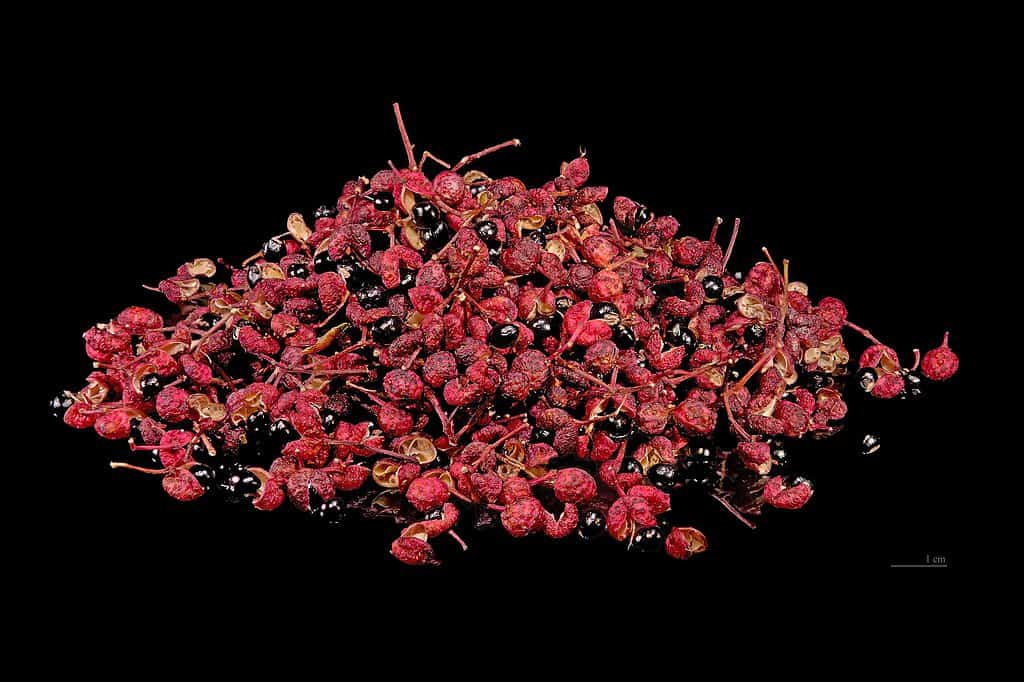
The dried seeds are used for culinary and medicinal purposes.
©
Common Problems of Chinese Pepper Bonsai
The Chinese pepper isn’t terribly prone to many of the common issues of bonsai trees, however there are a few things to keep an eye out for.
Aphids
As winter comes to a close, aphids may crop up on your Chinese pepper bonsai. It’s best to use a gentle, nontoxic pesticide if you notice these little dots on the underside of your leaves.
Root Rot
The other potential issue that likely could arise in your Chinese pepper is root rot. This occurs when the plant is over watered, or the water becomes stagnant within the bonsai pot. To deal with this, you will likely need to re-pot the plant, removing the over-saturated soil and replacing it with fresh, new soil. Ideally, give the soil some time to dry out (in other words, skip watering for a while) and gently massage the soil to help the water release. If it doesn’t start to dry out within a few days, you may need to consider re-potting.
Molds and other issues are rarely the result of the over watering, if they do crop up, use a gentle fungicide to eliminate the issue.
How to Propagate Chinese Pepper Bonsai
There are three ways that Chinese pepper bonsai may be propagated: seeds, cuttings, and air layering. Air layering is the least successful and most difficult, so most folks use seeds or cuttings.
To grow from seeds, grow the seeds as normal, via a proper seed starting mix. Water and provide light as necessary and keep the seeds warm.
To grow from cuttings:
- Take cuttings from the mother plant.
- Place the cuttings, cut end down, into bonsai soil that is well-draining.
- Keep the cuttings warm and moist, with plenty of light.
Chinese Pepper Bonsai FAQs
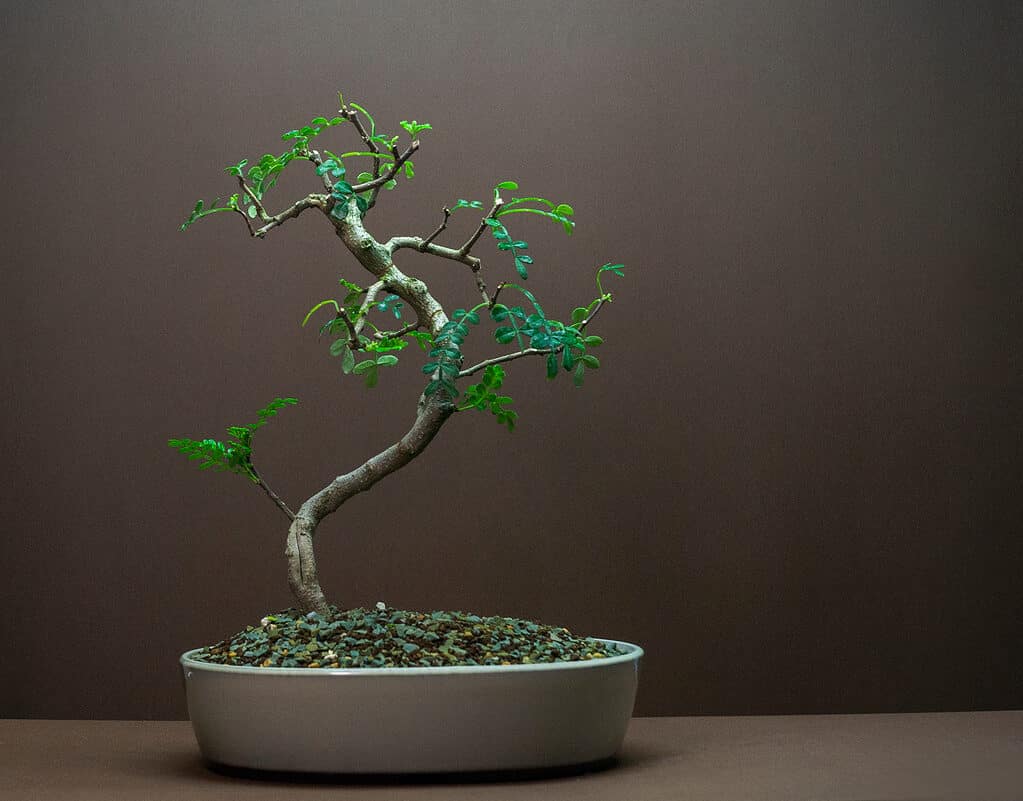
Even as young bonsai, they are intriguing looking trees.
©pjatnica/Shutterstock.com
Are Chinese peppers good for beginners?
If you’re new to the bonsai art form, the Chinese pepper is an excellent choice for you. They do have some specific requirements, of course, but because of their flexibility, year-round growth and care type, they are an excellent choice.
Is the Chinese pepper related to the Japanese pepper?
The Chinese and Japanese pepper are actually the same plant species. The difference is that one is endemic to Japan, while the other is endemic to China. They are virtually the same in every way apart from the location from which they come.
Are Chinese peppers annuals or perennials?
Chinese pepper are perennial plants, which is part of what makes them useful as bonsai trees. They may live for many years when cared for properly.
Can I grow my Chinese pepper bonsai indoors?
Absolutely! The Chinese pepper bonsai is one of the best species for indoor growing. They thrive in temperate climates, which much of the world cannot provide. They do need enough light, air circulation, and proper moisture levels and humidity, however, so they do require some particular care when kept indoors. Avoid placing them near vents, heaters, air conditioners, and doors that open to the outside, use a moisture meter, mist the foliage regularly, and add grow lights if they don’t get enough natural lighting to keep the leaves plentiful.
Up Next:
The photo featured at the top of this post is © lssa_007/Shutterstock.com
Thank you for reading! Have some feedback for us? Contact the AZ Animals editorial team.







